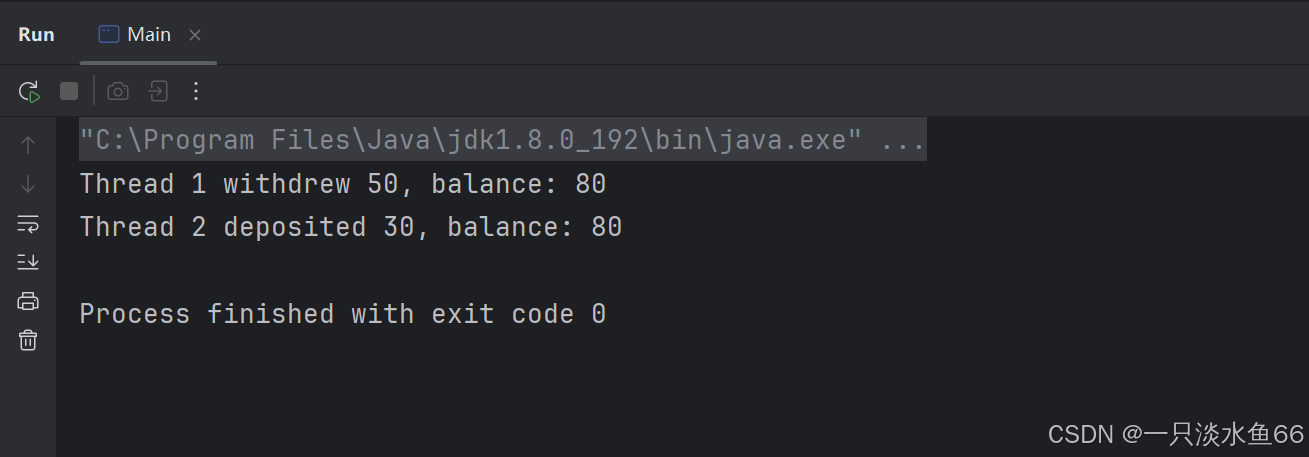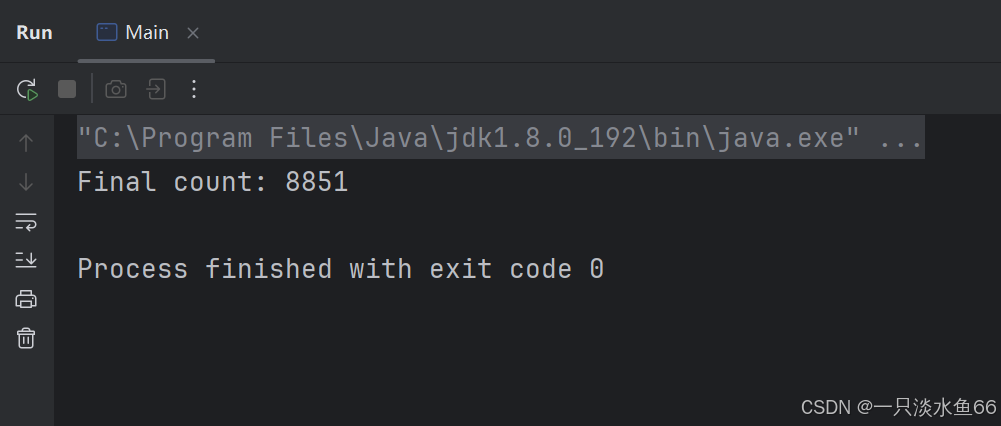产生线程不安全的原因在Java多线程编程中,线程不安全通常是由于多个线程同时访问共享资源而引发的竞争条件。以下是一些导致线程不安全的常见原因:
产生线程不安全的案例以及应对方法共享可变状态案例我们将创建一个简单的银行账户类,多个线程并发访问该账户进行存款和取款操作。假设我们有两个线程同时对账户进行操作,可能会出现余额计算错误的情况。 [code]class BankAccount { private int balance = 100; // 初始余额为100 public void deposit(int amount) { balance += amount; // 存款 } public void withdraw(int amount) { balance -= amount; // 取款 } public int getBalance() { return balance; // 返回当前余额 } } public class UnsafeBank { public static void main(String[] args) { BankAccount account = new BankAccount(); // 创建两个线程同时操作 Thread t1 = new Thread(() -> { account.withdraw(50); System.out.println("Thread 1 withdrew 50, balance: " + account.getBalance()); }); Thread t2 = new Thread(() -> { account.deposit(30); System.out.println("Thread 2 deposited 30, balance: " + account.getBalance()); }); t1.start(); t2.start(); } } [/code]运行情况:  我们期望的运行结果是:取款50,余额50、存款30,余额80。但是上述结果并不是我们想要的 分析 在上述代码中,两个线程同时对balance变量进行操作,可能导致不一致的余额输出。例如,假设Thread 1先读取了余额为100,然后进行了取款操作,但在它更新余额之前,Thread 2可能已经读取了余额并进行了存款操作。最终的结果可能不符合预期。 解决方法为了解决这个线程不安全的问题,我们可以使用synchronized关键字来确保对共享资源的访问是线程安全的。我们可以对deposit和withdraw方法加锁,使得同一时间只有一个线程能够执行其中一个方法。 以下是修改后的代码: [code]class BankAccount { private int balance = 100; // 初始余额为100 // 存款操作 public synchronized void deposit(int amount) { balance += amount; // 存款 } // 取款操作 public synchronized void withdraw(int amount) { balance -= amount; // 取款 } // 返回当前余额 public int getBalance() { return balance; // 返回当前余额 } } public class SafeBank { public static void main(String[] args) throws InterruptedException { BankAccount account = new BankAccount(); // 创建两个线程同时操作 Thread t1 = new Thread(() -> { account.withdraw(50); System.out.println("Thread 1 withdrew 50, balance: " + account.getBalance()); }); Thread t2 = new Thread(() -> { account.deposit(30); System.out.println("Thread 2 deposited 30, balance: " + account.getBalance()); }); t1.start(); t2.start(); // 等待两个线程结束 t1.join(); t2.join(); // 输出最终余额 System.out.println("Final balance: " + account.getBalance()); } } [/code]结果 在修改后的代码中,由于对deposit和withdraw方法加了synchronized修饰,确保任何时刻只有一个线程可以执行这两个方法,从而避免了由于竞争条件导致的不一致性。最终输出的余额将与预期结果相一致。  指令重排序案例指令重排序是指在编译、优化或CPU执行过程中,代码的执行顺序被改变。 count++ 操作并不是一个原子操作,它是由三个步骤组成的:
在多线程环境中,多个线程可能会同时对同一变量进行 count++ 操作,导致结果不正确。这种情况下,指令重排序可能导致某些操作无法达到预期结果。 以下是一个示例代码,演示了这个问题: [code]class Counter { private int count = 0; public void increment() { count++; // 不安全的操作 } public int getCount() { return count; } } public class CountExample { public static void main(String[] args) throws InterruptedException { Counter counter = new Counter(); Thread[] threads = new Thread[10]; // 创建10个线程 for (int i = 0; i < 10; i++) { threads[i] = new Thread(() -> { for (int j = 0; j < 1000; j++) { counter.increment(); // 增加计数 } }); } // 启动所有线程 for (Thread thread : threads) { thread.start(); } // 等待所有线程结束 for (Thread thread : threads) { thread.join(); } // 输出最终计数 System.out.println("Final count: " + counter.getCount()); } } [/code]运行结果:  我们的预期结果是:10000 分析 在上述代码中,我们创建了10个线程,每个线程执行1000次 increment() 方法,从而期望最终的计数是10000。然而,由于 count++ 操作的非原子性,在多个线程并发执行时,可能会导致某些增量操作丢失,最终结果可能小于10000。 解决方法为了解决这个问题,可以使用以下几种方法:
我们将采用第二种方法,即使用 AtomicInteger 来解决这个问题。 以下是修改后的代码: [code]import java.util.concurrent.atomic.AtomicInteger; class Counter { private AtomicInteger count = new AtomicInteger(0); // 使用AtomicInteger public void increment() { count.incrementAndGet(); // 原子性增加 } public int getCount() { return count.get(); // 获取当前值 } } public class SafeCountExample { public static void main(String[] args) throws InterruptedException { Counter counter = new Counter(); Thread[] threads = new Thread[10]; // 创建10个线程 for (int i = 0; i < 10; i++) { threads[i] = new Thread(() -> { for (int j = 0; j < 1000; j++) { counter.increment(); // 增加计数 } }); } // 启动所有线程 for (Thread thread : threads) { thread.start(); } // 等待所有线程结束 for (Thread thread : threads) { thread.join(); } // 输出最终计数 System.out.println("Final count: " + counter.getCount()); } } [/code]不可见性案例我们使用了两个线程 t1 和 t2。线程 t1 负责不停地检查一个共享变量 fag,而线程 t2 则在休眠1秒后将 fag 设为1。 [code]public class Main { public static int fag = 0; public static void main(String[] args) throws InterruptedException { Thread t1 = new Thread(() -> { while (fag == 0) { } }); Thread t2 = new Thread(() -> { try { Thread.sleep(1000); } catch (InterruptedException e) { throw new RuntimeException(e); } fag = 1; }); t1.start(); t2.start(); t1.join(); t2.join(); System.out.println("主线程结束"); } }[/code]分析 在Java中,fag 是一个共享的静态变量,初始值为0。线程 t1 在一个循环中不断检查 fag 的值,而线程 t2 在休眠1秒后将 fag 更新为1。根据Java内存模型的规定,线程可以在运行过程中缓存某些变量,以提高性能。这意味着,线程 t1 可能在自己的工作内存中读取到fag的值,并且不会每次都去主内存中检查当其值变化时。 因此,虽然 t2 可能已经将 fag 设置为1,但如果 t1 线程没有看到这个变化,它仍然可能会在其循环中继续查看到 fag 为0,导致 t1 线程陷入死循环,程序执行不会继续下去。 解决方法为了解决这个线程不可见性的问题,可以使用以下两种常见方法:
在这里,我们选择使用 volatile 关键字来解决这个问题。 [code]public class Main { public static volatile int fag = 0; // 使用volatile关键字 public static void main(String[] args) throws InterruptedException { Thread t1 = new Thread(() -> { while (fag == 0) { // Busy wait: 这里循环等待fag变为1 } }); Thread t2 = new Thread(() -> { try { Thread.sleep(1000); } catch (InterruptedException e) { throw new RuntimeException(e); } fag = 1; // 将fag设置为1 }); t1.start(); t2.start(); t1.join(); t2.join(); System.out.println("主线程结束"); } } [/code]结果 通过将 fag 声明为 volatile,确保了对该变量的写入会使得线程 t1 线程能看到 fag 的最新值。即使线程 t2 在将 fag 改为1后,其他线程(如 t1)也能及时看到这一变化,而不会出现不可见性的问题,从而避免了 t1 进入死循环的情况。 在程序运行结束后,您将看到"主线程结束"的输出,表明所有线程都能正常结束。使用 volatile 关键字有效地解决了线程间的可见性问题。 死锁在多线程编程中,死锁是一种非常严重的问题,它会导致程序无法继续执行。产生死锁的典型条件通常可以归纳为以下四个必要条件:
死锁案例假设有两个线程,线程A和线程B,它们分别需要获取两个锁,锁1和锁2。以下是代码示例: [code]class Lock { private final String name; public Lock(String name) { this.name = name; } public String getName() { return name; } } public class DeadlockExample { private static final Lock lock1 = new Lock("Lock1"); private static final Lock lock2 = new Lock("Lock2"); public static void main(String[] args) { Thread threadA = new Thread(() -> { synchronized (lock1) { System.out.println("Thread A: Holding lock 1..."); // Simulate some work try { Thread.sleep(100); } catch (InterruptedException e) {} System.out.println("Thread A: Waiting for lock 2..."); synchronized (lock2) { System.out.println("Thread A: Acquired lock 2!"); } } }); Thread threadB = new Thread(() -> { synchronized (lock2) { System.out.println("Thread B: Holding lock 2..."); // Simulate some work try { Thread.sleep(100); } catch (InterruptedException e) {} System.out.println("Thread B: Waiting for lock 1..."); synchronized (lock1) { System.out.println("Thread B: Acquired lock 1!"); } } }); threadA.start(); threadB.start(); } } [/code]分析 在上面的代码中,线程A首先持有锁1,然后尝试去获取锁2。同时,线程B首先持有锁2,之后尝试获取锁1。这样就形成了循环等待,导致两个线程相互阻塞,从而发生死锁。 解决方法为了避免这种死锁情况,可以使用以下解决方案:
在这个示例中,无论线程A还是线程B,都会按照同样的顺序(首先获取lock1,然后是lock2)来请求锁,由此避免了死锁情况的发生。 通过这些方法,可以有效减少多线程程序中的死锁风险,保证程序的稳定性。 为了有效避免死锁,可以考虑以下策略:
通过合理的设计与计划,可以有效减少死锁的可能性,提高系统的稳定性和可靠性。 免责声明:本内容来源于网络,如果侵犯了您的权益,请联系站长,我们会及时删除侵权内容,谢谢合作! |
